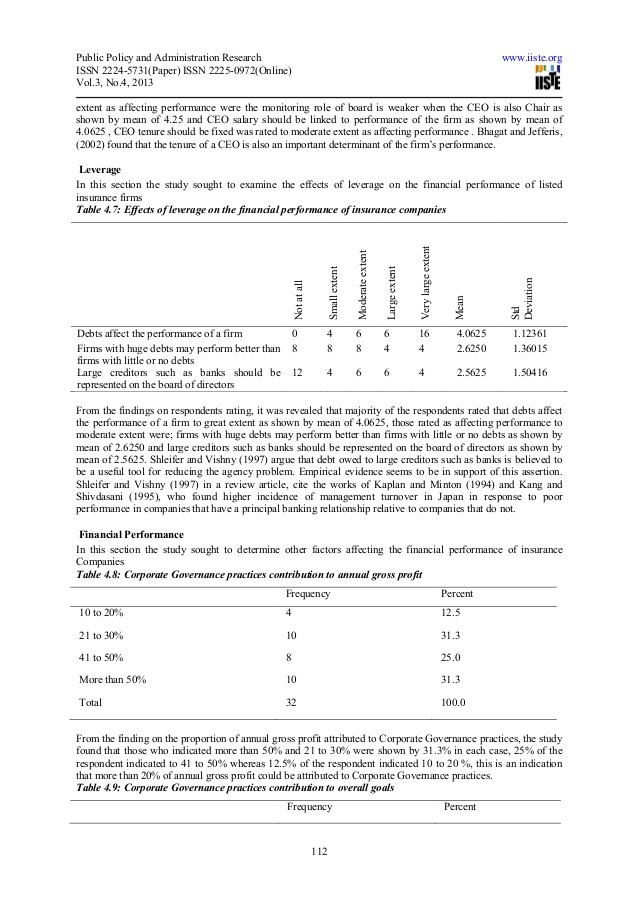How Corporate Governance Affects Performance
Post on: 3 Июль, 2015 No Comment

How Corporate Governance Affects Performance
April 1, 2005 Alan Lavine
Initial research indicates that better-governed companies do better.
Keep an eye on corporate, pension fund and mutual fund governance policies. How corporations and institutional fund portfolio managers exercise their fiduciary responsibilities may impact investment returns.
Fiduciary Analytics of Sewickley, Pa. and Morningstar of Chicago recently began rating mutual funds based on fiduciary issues. Later this year, Standard and Poor’s is expected to enter the fray.
However, there are few empirical studies on fiduciary quality and performance at the corporate and pension-fund levels. The jury still is out with mutual funds. There hasn’t been much empirical evidence because it is difficult to compare qualitative data on fiduciary performance and quantitative performance data, says Hany A. Shawky, finance professor and director of University of Albany’s Center for Institutional Investment Management. But casual observations show that corporate boards (and pension and mutual funds) that have strong governance usually perform better.
Although it is difficult to quantify fiduciary ability, recent studies show a strong relationship between fiduciary responsibility and performance. Negative corporate governance policies result in lower stock valuations and stock returns, according to one working-paper study by Harvard Law School professors Lucian Bebchuk and Allen Ferrell and Alma Cohen of the National Bureau of Economic Research.
The study examined 24 governance provisions of the Investor Responsibility Research Center (IRRC), New York, and their correlation to a company’s stock value and shareholder returns. The IRRC monitors the 24 provisions, which appear beneficial to management, for institutional investors and corporate governance researchers.
In the study, What Matters in Corporate Governance, published last November by the John M. Olin Center for Law Economics and Business, the researchers designed an entrenchment index of six IRRC provisions that benefit management but not shareholders. Four are constitutional provisions that limit shareholder powers and two are takeover provisions that benefit management.
The constitutional provisions are staggered boards of directors, limits to shareholder bylaw amendments, supermajority requirements for mergers and supermajority requirements for charter amendments. The takeover readiness provisions, poison pills and golden parachutes are put in place by boards to prepare for hostile takeover bids.
The researchers analyzed IRRC reports on governance arrangements of companies that represented more than 90% of the total U.S. stock market capitalization from September 1990 to February 2002. They rated the companies based on entrenchment index scores, the lowest being zero and the highest five.
A measure of performance, Tobin’s Q, was used to analyze a company’s stock valuation. Tobin’s Q is equal to the market value of assets divided by the book value of assets. The market value of assets is computed as the book value of assets plus the market value of common stock, less the sum of the book value of common stock and balance sheet deferred taxes.
The researchers used some complex calculations to analyze stock returns, based on Fama-French benchmarks. They looked at actual stock returns less the predicted normal returns.
The study revealed that the majority-18 of the 24 IRRC provisions-did not negatively impact stock valuations or performance. They were not negatively correlated with either a company’s stock value or stock returns from 1990 to 2003.
However, six provisions of the entrenchment index had a -0.044 correlation to a firm’s valuation, as measured by Tobin Q, indicating a negative impact on stock valuations and performance. The researchers found that if investors had gone long on stocks with low entrenchment indexes and simultaneously shorted stocks with high entrenchment indexes, they could have earned a return as high as 1% per month on the transactions.
On the pension fund side, a study by three consulting advisory firms indicated that improving a pension fund’s organizational structure enhanced fund performance.
That study, by Keith Ambachtsheer, Ronald Capelle and Tom Scheibelhut, quantified pension funds’ fiduciary and related guidelines to performance. The report, published in the November/December 1998 issue of the Financial Analysts Journal, analyzed the returns on 50 pension funds from 1993 through 1996.
In the study, Improving Pension Fund Performance, the researchers asked pension funds to complete a questionnaire. A metric scale from 0 to 100 was created, based on the degree of clarity in the organization’s structure.
The pension funds underperformed their passive policy benchmark by 60 basis points annually. However by improving a pension fund’s organizational structure, which includes the decision-making process, resources and clarity of goals, fund performance improved.
More precise and clear fiduciary guidelines had a statistically significant effect on returns, based on the risk-adjusted net value added return (RANVA). RANVA is a standardized pension fund calculation that adjusts the gross asset return for operating costs and risks.
The study’s results, using a sample size of just six, show that the coefficient of determination (R squared), which tells how much one variable contributes to the other variables’ behavior, was 0.60. The R squared translates into a 77% correlation between performance and the pension funds’ organizational accountability structure.
The study shows that good organizational framework contributes to performance, says John Ilkiw, director of research and strategy with the Russell Investment Group in Tacoma, Wash. The reason: Clearly defined roles, procedures and accountability within the investment organization are carried out effectively.
However, Ilkiw suspects that the correlation between performance and fiduciary quality may be lower today. The reasons: The correlation was performed on a small sample size and the investment environment is different today compared with the mid-1990s.
You can’t hang your hat on one statistic because there are other random factors going on, he said. But the Ambachtsheer study shows that the clarity of the fiduciary process is important. Fiduciaries have to have clear investment and risk guidelines and avoid unwanted consequences.
On the mutual fund side, it is too early to tell if funds with high fiduciary ratings will be top performers. Companies with good governance perform well, so you are almost certain to find a strong correlation between fiduciary responsibility and mutual fund performance, says the Center for Institutional Investment Management’s Shawky. But it could take several years of data before you can say with a great deal of conviction that funds with high fiduciary ratings will outperform funds with lower ratings.
He says the big problem with the new mutual fund rating services: It is hard to quantify fiduciary behavior. And when a third party evaluates fiduciary activity, an extra layer of judgment is added to the process.
Shawky believes independent boards of directors are an important variable in mutual fund stewardship. Analysts need to do an intensive evaluation of the members of a mutual fund’s independent board of directors before they rate the funds. They need to investigate the board members’ financial education and work experience. They need to find out how many other boards they work on and their past relationships with an investment company.

In addition, the mutual fund analyst also should look into the investment company’s trading activities. This activity has been overlooked in the fiduciary grading process.
Some of the data is very soft, he says. Over time, better measures will be developed.
Nevertheless, mutual funds that operate in the best interest of their shareholders should fare well. A preliminary study in the January 2005 Financial Advisor found that mutual fund families with high fiduciary ratings by Fiduciary Analytics also register higher Morningstar fund family stock fund scores. The Morningstar Fund Family Score is an asset-weighted average of a fund company’s Morningstar performance ratings, also known as star ratings, within an asset class.
Morningstar has assigned fiduciary grades, called stewardship grades, to 985 funds. More than 2,000 funds will be rated when the project is complete. Morningstar assigns funds a stewardship grade from A, the highest, to F, the lowest. The grades are based on the evaluation using a number of criteria regarding regulatory issues, board quality, manager incentives, fees and corporate culture. For more information go to www.morningstar.com. Then click on mutual fund and stewardship.
A preliminary analysis shows that the relationship between Morningstar’s individual fund fiduciary grade and performance seems to hold up. But it is too soon for a meaningful statistical analysis to be performed. Several years of data are needed before the degree of association between stewardship grades and performance is valid.
That said, at the time of this writing, there were 51 large-company growth-stock funds that have stewardship ratings by Morningstar. The relationship between their ratings and their one-year performance ending December 2004 was favorable. Funds A rated had the best stewardship scores. Funds rated F were the worst. The performance results of the growth stock funds with stewardship grades show:
A-rated growth stock funds had a median return of 10.1%.
B-rated growth stock funds had a median return of 9.6%.
C-rated growth stock funds had a median return of 8.1%.
D-rated growth stock funds had a median return of 6.3%.
F-rated growth stock funds had a median return of 7.1%.
Although A- and B-rated funds exhibited the best returns, funds with lower stewardship ratings also performed well. For example, the Franklin Capital Appreciation fund, rated C by Morningstar, grew 16.02% over the year, and the Columbia Growth Fund, rated F by Morningstar, gained 8.03%. By contrast, the average large-company growth stock fund gained 7.64% in 2004.
Alan Lavine is author of numerous books and a contributing editor to Financial Advisor.














